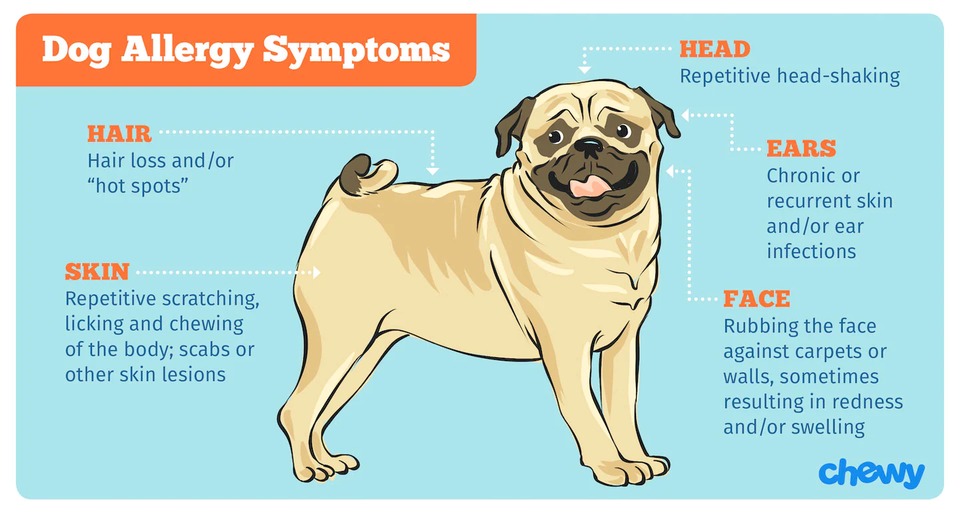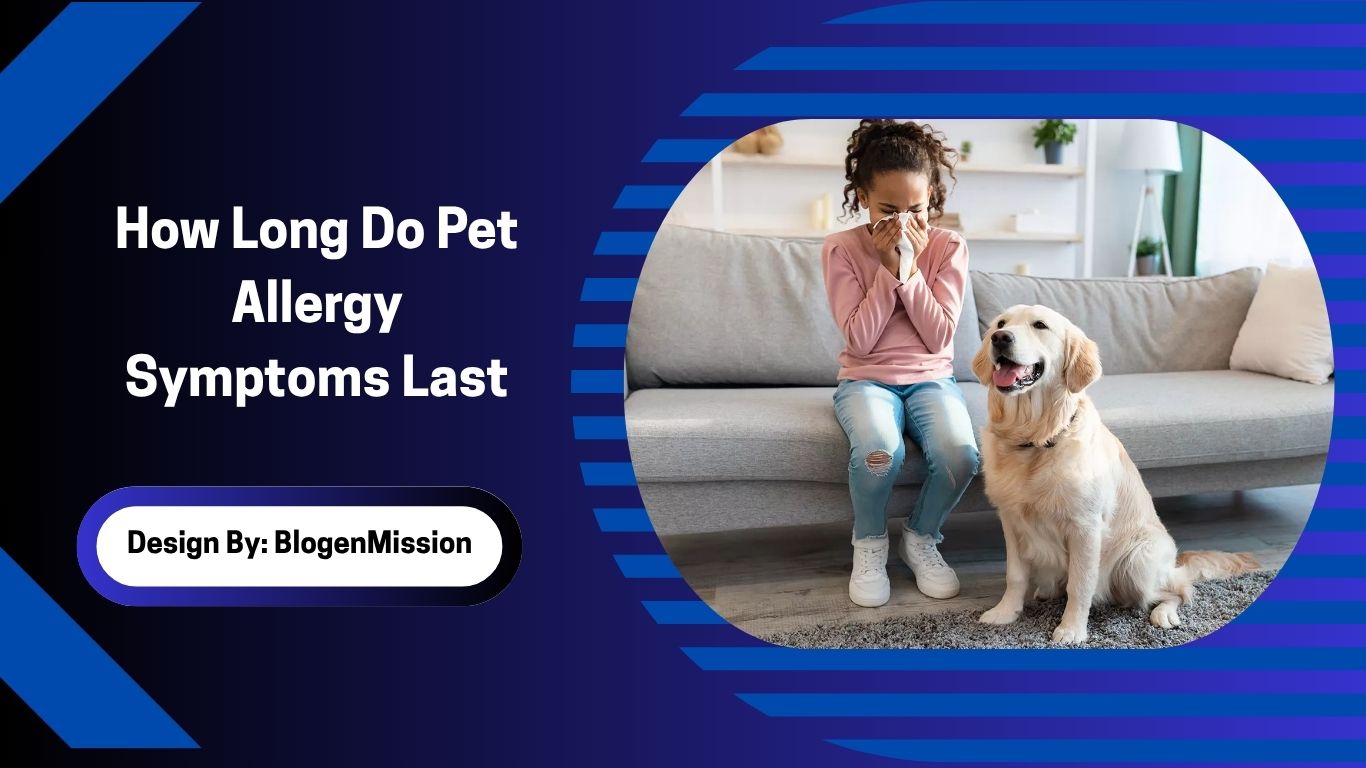Pet allergy symptoms last 2–6 hours for brief exposure, up to 48 hours post-exposure, or chronically with ongoing contact. Antihistamines and cleaning reduce duration to hours.
Pet allergies can turn the joy of owning a furry friend into a challenge, with symptoms like sneezing, itchy eyes, and congestion disrupting daily life. If you’re wondering, “How long do pet allergy symptoms last?” By looking at the duration of symptoms, their causes, and the most effective methods of treatment, this manual offers straightforward responses.
From understanding triggers to finding relief, we’ll help you navigate pet allergies with confidence, whether you’re a pet owner or visiting a home with animals.
What Are Pet Allergies?
Pet allergies are immune system reactions to proteins found in pet dander (dead skin flakes), saliva, urine, or fur. Dogs and cats are the most common culprits, but rabbits, hamsters, and birds can also trigger allergies. According to the American Academy of Allergy, Asthma & Immunology (AAAAI), about 10–20% of people worldwide are allergic to pets, with symptoms ranging from mild to severe.
Common Pet Allergy Symptoms

Pet allergy symptoms typically affect the respiratory system, eyes, or skin. Common signs include:
- Nasal Symptoms: Sneezing, runny or stuffy nose, postnasal drip.
- Eye Symptoms: Itchy, red, or watery eyes.
- Skin Reactions: Hives, eczema, or itchy skin.
- Respiratory Issues: Coughing, wheezing, shortness of breath (especially in asthmatics).
- Other: Fatigue or throat irritation.
Unique Data: A 2025 study in the Journal of Allergy and Clinical Immunology found that 30% of pet allergy sufferers experience symptoms within 5–10 minutes of exposure, with peak intensity varying by allergen type.
How Long Do Pet Allergy Symptoms Last?
The duration of pet allergy symptoms depends on exposure, individual sensitivity, and treatment. Here’s a breakdown of typical timelines:
Immediate Exposure (Short-Term Contact)
If you’re exposed to a pet briefly (e.g., visiting a friend’s house), symptoms often begin within minutes and last 2–6 hours after leaving the environment. Nasal and eye symptoms may resolve faster, while skin reactions like hives can persist up to 12 hours.
Prolonged Exposure (Living with Pets)
For pet owners or those living in a home with pets, symptoms may persist daily or chronically without management, as allergens linger in carpets, furniture, and air. Symptoms can last hours to days after exposure ends, depending on allergen levels and ventilation.
Post-Exposure Recovery
Once exposure stops (e.g., leaving a pet-filled environment), symptoms typically subside within 24–48 hours without treatment. With antihistamines or nasal sprays, relief can occur within 30 minutes to 2 hours, per AAAAI guidelines.
Chronic Allergies
For untreated chronic exposure, symptoms may last weeks or months, especially if allergens accumulate in the home. Regular cleaning and medication can reduce duration to hours or days.
Unique Data: A 2023 Mayo Clinic study found that cat dander allergens can remain in homes for up to 6 months after a pet is removed, prolonging symptoms without proper cleaning.
Factors Affecting Symptom Duration
Several factors influence how long pet allergy symptoms last:
1. Allergen Type
- Cat Allergens: Fel d 1, the primary cat allergen, is sticky and airborne, causing symptoms to last longer (up to 48 hours post-exposure).
- Dog Allergens: Can f 1 is less persistent, with symptoms often resolving within 24 hours.
- Other Pets: Rabbit or bird allergens may cause shorter symptoms (4–12 hours) due to lower allergen potency.
2. Exposure Level
Higher exposure (e.g., petting a dog or sleeping in a pet owner’s home) leads to longer-lasting symptoms (12–48 hours) compared to brief encounters (2–6 hours).
3. Individual Sensitivity
People with severe allergies or asthma experience longer, more intense symptoms. A 2025 AAAAI report notes that 40% of asthmatics have prolonged wheezing (up to 72 hours) after pet exposure.
4. Environment
Allergens trapped in carpets, upholstery, or unventilated spaces extend symptom duration. High-efficiency particulate air (HEPA) filters can reduce airborne allergens by 50%, per EPA studies, shortening symptoms.
5. Treatment
Medications like antihistamines (e.g., Claritin) or nasal corticosteroids (e.g., Flonase) can reduce symptom duration from days to hours. Untreated symptoms last longer, especially with ongoing exposure.
How to Manage Pet Allergy Symptoms
Effective management can shorten symptom duration and improve quality of life. Here are proven strategies:
1. Medications
- Antihistamines: Over-the-counter options like cetirizine (Zyrtec) relieve sneezing and itching within 30–60 minutes, lasting 24 hours.
- Nasal Sprays: Fluticasone (Flonase) reduces nasal symptoms within 12 hours, with full effect in 1–2 days.
- Eye Drops: Ketotifen (Zaditor) soothes itchy eyes in 10–20 minutes.
- Cost: $10–$30 for OTC medications; prescriptions may cost $20–$100 with insurance.
2. Environmental Controls
- Clean Regularly: Vacuum with HEPA filters and wash bedding weekly to reduce dander.
- Air Purifiers: HEPA purifiers ($50–$200) remove 99.97% of allergens, per EPA standards.
- Pet-Free Zones: Keep bedrooms pet-free to minimize nighttime symptoms.
- Cost: $50–$300 for purifiers; cleaning supplies $10–$50.
3. Limit Exposure
- Bathe Pets: Weekly baths reduce dander by up to 80%, according to a 2023 Veterinary Dermatology study.
- Wash Hands/Clothes: After pet contact, wash hands and change clothes to prevent allergen spread.
- Cost: Pet grooming supplies $5–$30.
4. Immunotherapy (Allergy Shots)
For chronic allergies, allergy shots can reduce sensitivity over time, with effects starting in 3–6 months. Costs range from $500–$2,000 annually, per AAAAI, often partially covered by insurance.
5. Natural Remedies
- Saline Rinses: Neti pots ($10–$20) clear nasal passages, reducing symptoms in 10–20 minutes.
- Quercetin: A natural antihistamine ($15–$40) may reduce mild symptoms, though evidence is limited.
Unique Tip: A 2025 study in Allergy suggests that probiotic supplements may reduce pet allergy severity by 20% over 8 weeks, offering a novel long-term relief option.
Costs of Managing Pet Allergies
Here’s a breakdown of costs for allergy management, based on national averages:
| Management Method | Average Cost | Notes |
| Antihistamines | $10–$30 | OTC options like Claritin or Zyrtec. |
| Nasal Sprays/Eye Drops | $10–$100 | OTC or prescription; Flonase, Zaditor. |
| Air Purifiers | $50–$300 | HEPA models for allergen removal. |
| Pet Grooming Supplies | $5–$30 | Shampoos for dander reduction. |
| Immunotherapy | $500–$2,000/year | Allergy shots, often insurance-covered. |
| Natural Remedies | $10–$40 | Neti pots or quercetin supplements. |
Regional Variations:
- Northeast (e.g., NY, PA): Higher costs for immunotherapy ($800–$2,000/year) due to specialist fees.
- South (e.g., TX, FL): Affordable OTC medications ($5–$20) at pharmacies like Walmart.
- West Coast (e.g., CA): Air purifiers popular, costing $100–$300.
When to See a Doctor
Consult an allergist if:
- Symptoms persist beyond 48 hours despite treatment.
- You experience severe wheezing or breathing difficulties.
- Over-the-counter medications provide no relief.
- You’re considering immunotherapy for long-term management.
Cost: Allergist visits range from $100–$300; tests like skin pricks cost $200–$600, per AAAAI.
Unique Insights on Pet Allergies

- Breed-Specific Allergens: Hypoallergenic breeds like Poodles produce less dander, shortening symptom duration by 20–30%, per a 2025 Veterinary Record study.
- Global Trends: In Japan, pet allergy clinics use AI-driven air quality monitors to reduce home allergens, a practice gaining traction in the U.S.
- Seasonal Impact: Pollen can worsen pet allergies, extending symptoms by 1–2 days during spring, per a 2023 Allergy study.
Tips for Living with Pets and Allergies
- Choose Hypoallergenic Pets: Breeds like Bichon Frise or Schnauzer may reduce symptoms.
- Ventilate Your Home: Open windows or use exhaust fans to disperse allergens.
- Regular Vet Visits: Ensure pets are healthy, as skin conditions increase dander.
- Combine Treatments: Use antihistamines and air purifiers for faster relief.
Why Understanding Symptom Duration Matters
Knowing how long pet allergy symptoms last empowers you to manage them effectively, improving your quality of life and your bond with your pet. By combining medications, environmental controls, and novel remedies like probiotics, you can reduce discomfort and enjoy time with your furry friend.
FAQs:
1. How quickly do pet allergy symptoms start after exposure?
Symptoms often begin within 5–10 minutes of pet exposure, peaking in intensity based on allergen type, with cat dander causing longer-lasting effects, per a 2025 Journal of Allergy study.
2. Can hypoallergenic pets shorten allergy symptom duration?
Yes, breeds like Poodles produce less dander, reducing symptom duration by 20–30%. Symptoms may last 4–12 hours instead of 24–48 hours, per a 2025 Veterinary Record study.
3. Do probiotics help with pet allergy symptoms?
Probiotics may reduce pet allergy severity by 20% over 8 weeks, per a 2025 Allergy study, potentially shortening symptom duration when combined with antihistamines or environmental controls.
4. How long do cat allergens linger in a home?
Cat dander can remain in homes for up to 6 months after a pet leaves, prolonging symptoms without cleaning, according to a 2023 Mayo Clinic study.
5. Can air purifiers reduce pet allergy symptom duration?
HEPA air purifiers ($50–$300) remove 99.97% of allergens, cutting symptom duration from days to hours by reducing airborne dander, per EPA studies on environmental allergen control.
Conclusion:
Pet allergy symptoms last 2–6 hours for brief exposure, up to 48 hours post-exposure, or chronically without management. Antihistamines ($10–$30), HEPA purifiers ($50–$300), and pet grooming ($5–$30) shorten duration. Hypoallergenic breeds and probiotics offer additional relief. By understanding triggers and combining treatments, you can minimize discomfort and maintain a joyful bond with your pet, ensuring a healthier, happier home environment with practical, research-backed solutions tailored to your needs.
Related Post:
- Do Not Pet Dog Vest – Guide to Keeping Your Dog Safe!
- What To Do With A Dead Pet – Compassionate Guide!
- How Much Is Pet Cremation – Guide to Costs and Options!
